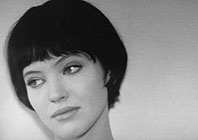|
|
|
|
Vivre sa vie
|
 |
|
Like
many film projects of Jean-Luc Godard, Vivre sa vie is held together
– more sturdily than much of his work – by the tension between opposing
artistic impulses.
On
the one hand, it was devised and shot very quickly, almost in the manner of
reportage – Godard had been perusing sociological studies of the period
concerning how easily Parisian women could drift into prostitution, once
financial hardship hit. Hence the sketchy tale of Nana (Anna Karina), from
relationship breakdown to bitter end, was born.
On
the other hand, this is among the most formal and composed of Godard’s films, in
its images and sounds, and in narrative construction: episodes or scenes from a
decline-and-fall melodrama, the content of which is labelled and spelt out in advance, in soberly Brechtian intertitles.
Godard
was still some years away from the full flowering of his political
consciousness, but already here a bleak view of society is developed: everybody
the camera examines is actually or potentially either pimp,
whore or client in this go-round of need and consumption.
And
yet, for all that, it is a stunningly lyrical film, giving us some of Godard’s most
achieved scenes, balanced between (to use the words of philosopher Simone Weil)
“gravity and grace”.
And
never more so than in Nana’s entrancing dance around a pool hall to the tune of
a generic pop instrumental confected by Michel Legrand (“Swing, swing, swing!”, its chorus helpfully exhorts). It’s in moments like
these we recall the wise words of the late, great critic Gilberto Perez, from
his 2000 book The Material Ghost – Films
and Their Medium: “The lyricism celebrates the triumph, the
pathos laments the defeat of the soul that would assert itself, the tenderness
that would gain embodiment, the freedom that would achieve realisation”.
In
a prescient Cahiers du cinéma piece from 1962, the brilliant critic/video
artist Jean-André Fieschi (1942-2009) admiringly
called Godard a vampire – for the already familiar way he “borrowed so boldly”
from other films. But Fieschi took the idea further
and deeper, proposing that vampirism is among “the greatest myths of all cinema
and literature”, and that Vivre sa vie “plunges directly and
without the mediation of a fantasy premise” into its wellspring:
A film about absorption: shadow absorbs light
a dozen times (the fades to black); death absorbs life. Likewise Godard absorbs
the world and is finally himself absorbed by his creation (as expressed by “The
Oval Portrait”). (1)
It’s
no surprise that contemporary masters of video and installation art, including Harun Farocki and Atom Egoyan, have been so drawn to commenting on or reworking Vivre sa vie.
The film offers itself as a series of distinct tableaux that can easily be
re-imagined as separate screens in a gallery. As every true cinephile knows, Godard goes so far as to stage the viewing of a classic film (Carl
Dreyer’s The Passion of Joan of Arc,
1928) inside his own, Falconetti’s anguish prompting
Karina’s tears to roll – and Egoyan added a few more,
multi-media layers to that Chinese Box in his dazzling short, Artaud Double Bill (2007).
1.
Jean-André Fieschi (trans. Roberta Bernstein), “The
Difficulty of Being Jean-Luc Godard”, in Toby Mussman (ed.), Jean-Luc Godard (New York: E.P.
Dutton, 1968), p. 73 (translation modified). French original
in Cahiers du cinéma,
no. 137 (November 1962), pp. 14-25.
MORE Godard: Aria, À bout de souffle, Contempt, Soigne ta droite, Hélas pour moi, Histoire(s) du cinéma 1A & 1B, For Ever Mozart, Masculin Féminin, Éloge de l’amour, Sauve qui peut (la vie), La Chinoise, Made in USA, Film Socialism, Tout va bien, Alphaville, Ici et ailleurs © Adrian Martin February 2015 |
![]()